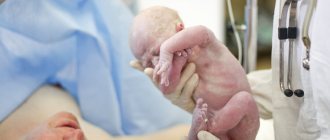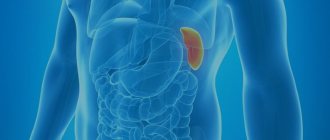Currently, the issue of parasites is acute in Russia. A large number of people are infected with intestinal protozoa and this number is steadily increasing.
A special place is given to such an invasion as blastocystosis. It is caused by the protozoa Blastocysts spp, which parasitize mainly in the large intestine. They multiply in the small intestine.
What to do in such a situation? To get started, we recommend reading this article. This article describes in detail methods of controlling parasites. We also recommend that you consult a specialist. Read the article >>>
Blastocystis Spp in humans - what is it?
Blastocysts spp (blastocysts) is a protozoan organism, a parasite of microscopic size: from 0.1 to 2 mm. Externally, blastocysts are a spherical surface consisting of tens or hundreds of cells. In the human body they are under the control of the immune system.
Blastocystis Spp in feces
Habitat: intestines of humans, animals, birds.
Blastocysts spp has 5 developmental stages. Under suitable conditions, Blastocysts spp cells form cysts. With a strong immune system, these cysts dissolve in the intestines; if the immune system fails, they multiply further.
In the cystic stage it is very difficult to destroy them. The mechanism of action is under study. When parasites enter the human body, they attach to the intestinal mucosa, and the process of reproduction occurs.
The first symptoms and the rate of development of the disease are directly proportional to the level of immune defense. In the process of their life activity, they release substances that, when released into the blood, lead to intoxication of the entire human body. As soon as a person’s immunity decreases, blastocysts begin to multiply intensively.
Negative effects on the human body:
- Suppress normal flora.
- IgG immunoglobulin is destroyed.
- They cause inflammation in the places where they are parasitized.
- They feed on the bacteria we need.
- They enter the bloodstream through the intestinal wall, injuring it.
A parasite distributed on all continents
Blastocystis is one of the most widely encountered human parasites in the world and has a global distribution. It is the most common parasitic infection in the United States, where it infected approximately 23% of the total population in 2000. In less developed areas, infection was observed in 100% of the study population. High rates of infection occur in people in developed countries who work with animals.
The role of Blastocystis hominis in human diseases is often cited as controversial in scientific work. However, a systematic review of studies by 11 infectious disease specialists from nine countries found that more than 95% of papers published 10 years earlier identified Blastocystis as causing disease in immunocompetent (those with normal immunity) people. This review article explains the confusion regarding the pathogenicity of Blastocystis. This is due to the existence of asymptomatic carriers. This phenomenon noted by the study is common to all gastrointestinal protozoa found in humans and animals. However, Blastocystis never fulfilled Koch's postulate: that infection of a healthy person results in disease.
The fact that the route of Blastocystis infection is oral indicates that carriers were in contact with fecal contamination, which could include other enteric pathogens that would explain the observed symptoms. Those. It is not a fact that the disease was caused specifically by blastocysts. A more likely explanation is the presence of virulent and non-virulent strains, since there is also enormous genetic variation between different strains (or genotypes). The alternative theory that Blastocystis is not a pathogen at all has recently been strengthened based on the biochemistry of the microorganism.
Symptoms of the protozoan Blastocystis Spp
The symptoms of Blastocystis Spp protozoa are not always pronounced. They appear only when the immune system malfunctions.
The main symptoms include:
- Skin rashes.
- Decreased appetite.
- Chills.
- Increased body temperature.
- Stomach ache.
- Diarrhea.
- Flatulence.
- Anal itching.
If you have abdominal pain or diarrhea, you should consult a doctor. Only on the basis of the tests carried out, in which the parasite is detected, will drug treatment be prescribed.
Blastocystis Spp in a child
Children are most susceptible to this disease. If there are no symptoms, even if Blastocystis Spp is present, then drug treatment may not be used.
Symptoms in children are similar to clinical manifestations in adults. The clinical picture may be more acute.
A warning sign should be the presence of persistent allergic reactions. Moreover, antiallergic drugs do not have any effect.
To establish an accurate diagnosis, it is necessary to confirm the presence of parasites in the child’s stool. To detect blastocysts in the stool, the PCR (polymerase chain reaction) method is used.
This method detects parts of the DNA of microorganisms. To establish a diagnosis of Blastocystosis, not only the results of PCR are taken into account, but also the number of leukocytes in the blood, and clinical confirmation of inflammation in the gastrointestinal tract is required.
Only a doctor, based on diagnostic data, will prescribe appropriate treatment.
Symptoms of blastocystosis
If you study the photos of patients, it becomes obvious that when infected, a small rash of an allergic nature appears on the skin. In addition, when a person is infected with blastocysts, the body temperature rises, and the condition of the gastrointestinal tract is similar to food poisoning. It is important to find out what could have caused the attack, while being aware that “it won’t go away on its own.” The effectiveness of treatment for blastocystis hominis depends entirely on the speed of response of the patient or his environment to the telltale symptoms of the underlying disease. Here are some complaints that may arise:
- increased intestinal spasms;
- flatulence and increased gas formation;
- violation of systemic digestion;
- sudden weight loss, bad breath;
- local and allergic reactions.
- Diagnosis of diabetes mellitus during pregnancy and its consequences
- Pea soup with smoked meats: recipes with photos
- How to kill a nerve in a tooth
Blastospores in stool
This is the main symptom of the disease, which can be detected exclusively by laboratory methods. Therefore, for successful treatment and effective prevention, the doctor, having found out all the patient’s complaints and suspecting blastocystosis, gives a referral for laboratory tests. The clinical picture is supplemented by collecting anamnesis data, blood tests ELISA and PCR, and ultrasound of the peritoneal organs. It is important to differentiate the diagnosis and then proceed to its successful treatment. Do not confuse it with the development of hymenolepidosis and filariasis, otherwise the use of medications will be in vain.
Blastocystis Spp: what and how to treat
Treatment of Blastocystis Spp is given in the table. The dosages given are general for everyone. It does not reflect the child’s age, old age, the presence of concomitant diseases, or the presence of allergic reactions.
The table is provided for informational purposes only.
| Medicine | Dosage of the drug | Reception frequency | Contraindications |
| Furazolidone | 0.1 g each | Four times a day. From 7 to 10 days | Pregnancy, breastfeeding, renal failure, age up to 3 years. |
| Metronidazole Metronidazole | 0.5 tablets | 2 times a day, 5 days | Organic lesions of the central nervous system, leukopenia. |
| Tiberal | 4 tablets | 1 tablet during the day | Diseases of the circulatory system, Pregnancy, breastfeeding, damage to the central nervous system. |
| Nimorazole | 0.5 g | 2 times a day | Age up to 5 years, pregnancy, breastfeeding, central nervous system disorders. |
| Tinidazole | 4 tablets | 1 per day | Age up to 5 years, pregnancy, breastfeeding, central nervous system disorders. |
For more detailed information, consult your doctor!
Introduction
Infectious and parasitic diseases remain one of the leading factors involved in the development of gastrointestinal tract (GIT) pathology.
Recently, special attention has been paid to blastocyst invasion due to its widespread occurrence and possible potential association with the development of irritable bowel syndrome (IBS). Blastocysts (Blastocystis spp., formerly Blastocystis hominis) are unicellular eukaryotic anaerobic microorganisms of the Stramenopiles group that parasitize the intestines of humans and animals. The ecological niche for Blastocystis spp. is the lumen of the cecum and proximal colon. The genus Blastocystis is represented by many morphologically indistinguishable subtypes, of which 17 are the most fully described to date. In humans, the most common variants are ST1, ST2 and ST3. It is assumed that representatives of different subtypes differ in pathogenic potential and degree of sensitivity to antiprotozoal drugs [1]. In stool samples and in vitro cultures, four main forms of blastocysts are recognized: vacuolar, granular, amoeboid and cystic [2]. Human infection with blastocysts occurs through the fecal-oral transmission mechanism: contact, household, water and food routes. This is facilitated by the stability of cysts in the external environment [3].
The prevalence of blastocyst invasion in the world varies widely (from 0.5 to 60%) and depends on the climatic, socio-economic, sanitary and epidemiological characteristics of the region, the research method and the characteristics of the population being studied [2, 4]. In St. Petersburg, according to some authors, the prevalence of blastocystic invasion is 10% of the number of apparently healthy individuals examined [5], but there is a significantly higher frequency among patients with HCV cirrhosis, which reaches 28.8% [6].
A number of studies demonstrate a positive association of blastocyst invasion with IBS [7–9], skin pathology [10, 11], and among pediatric patients with abdominal pain syndrome, diarrhea and weight loss. Blastocyst invasion has been described as the only identified cause of clinical manifestations [12]. Cases of blastocystic invasion have been described among immunocompromised and multimorbid patients [13–15].
The role of Blastocystis spp. in the pathogenesis of gastrointestinal diseases is not completely clear. Currently, most researchers point to both the potential and actual involvement of Blastocystis spp. in the pathogenesis of gastrointestinal diseases. According to most authors, the clinical manifestations of blastocyst invasion are nonspecific and range from asymptomatic carriage to severe gastroenterological symptoms - abdominal pain, stool disorders, flatulence, nausea, and skin manifestations (papular rash, itching), which is probably determined by the genetic polymorphism of blastocysts and the state of local immunity of the intestinal mucosa [16, 17].
According to experimental data, blastocyst proteases (including metalloproteinases, cysteine proteases, serine proteases) activate a cascade of proinflammatory cytokines, contribute to increased permeability of the intestinal wall and disruption of the qualitative and quantitative composition of the intestinal microbiota [8]. Data have been obtained according to which Blastocystis spp. influence the balance of the intestinal microbiota. Thus, in patients with blastocystic invasion, a decrease in the number of Bifidobacterium spp was found. and Faecalibacterium prausnitzii [7].
According to some authors, taking into account the different degrees of pathogenicity of blastocyst subtypes, the issue of prescribing eradication therapy must be decided individually. Thus, patients without clinical manifestations do not need to be prescribed antiprotozoal drugs, while in the presence of gastroenterological symptoms and skin manifestations, therapy is necessary [16, 17].
According to SanPiN 3.2.3215-14 “Prevention of parasitic diseases on the territory of the Russian Federation” (as amended as of December 29, 2015), preventive and anti-epidemic measures are regulated in relation to blastocysts, including treatment of patients with blastocyst infestation with monitoring of its effectiveness after 10–14 days. Recommended regimens of antiprotozoal therapy for Blastocystis spp. are presented in table. 1. Today, metronidazole remains the first-line drug. If metronidazole therapy is ineffective, second-line drugs are used: trimethoprim/sulfamethoxazole; nitazoxanide; paromomycin; tinidazole, etc. When treating blastocystic invasion, it is also advisable to use drugs to correct intestinal dysbiosis. Thus, in a randomized, single-blind clinical trial of blastocyst invasion in pediatric patients with gastroenterological symptoms (diarrhea, abdominal pain, nausea, flatulence), the effectiveness of a probiotic preparation based on Saccharomyces boulardii was established [18].
On the basis of the Peter the Great Clinic and the Department of Propaedeutics of Internal Diseases, Gastroenterology and Dietetics of North-Western State Medical University named after. I.I. Mechnikov conducted his own study, the purpose of which was to determine the prevalence of blastocystic invasion in patients with pathology of the digestive organs.
Methods
Using a continuous sampling method, the study included 130 patients with diseases of the digestive system who were on outpatient and inpatient treatment from March to June 2021, whose average age was 46.9±15.9 years (from 19 to 80 years), with predominance of females (68.5%). The structure of gastroenterological pathology in the examined patients is presented in the diagram (Fig. 1). There was a predominance of patients with inflammatory bowel diseases (IBD) - 36.1% (n=47), patients with IBS accounted for 26.1% (n=34), with diseases of the hepatobiliary system, incl. liver cirrhosis, functional disorders of the biliary tract – 15.3% (n=20). The study also included patients diagnosed with functional dyspepsia, gastroesophageal reflux disease, diverticular disease of the colon, unclassified colitis, and other gastrointestinal diseases (peptic ulcer, rectal cancer, Cl. difficile-associated colitis, exudative enteropathy).
All study participants filled out a questionnaire - a questionnaire aimed at identifying potential risk factors for infection with blastocysts, namely a low level of education, unfavorable communal conditions, the presence of concomitant somatic and infectious diseases, taking antibiotics, traveling to other regions, contact with animals, people with acute intestinal diseases, visiting public catering establishments, drinking unboiled water and visiting the swimming pool. Detection of blastocystic invasion was carried out by two methods of microscopy of a native stool smear with 2% Lugol's solution and the polymerase chain reaction (PCR) method with genus-specific primers for SSU rDNA Blastocystis spp. [19].
All patients with established blastocystic invasion received antiprotozoal therapy in accordance with international recommendations [17].
Research results
In 10.0% (n=13) of the total number of examined patients, microscopic examination of a native stool smear revealed Blastocystis spp. in vacuolar form in quantities from 1–2 to 5 or more microorganisms in the field of view, the results of the study were confirmed by PCR. No other protozoa and helminths were found in the examined patients. In 1 (0.77%) patient Blastocystis spp. were detected by microscopy of a native stool smear, but the protozoan DNA was not identified by PCR. Upon repeated microscopic examination of Blastocystis spp. were not detected, therefore the results of microscopic examination were regarded as false positive. In addition, using DNA PCR of Blastocystis spp. was identified in two patients with negative results on microscopic examination, which is likely due to the low number of blastocysts in the studied material.
Thus, in contrast to the method of microscopy of a native stool smear, blastocysts were detected by PCR in 11.5% (n=15) of patients of the total number of patients examined. Therefore, to increase the reliability of the detection results of Blastocystis spp. It is advisable to use a combination of methods: microscopy of a native stool smear and identification of blastocyst DNA by PCR, which is consistent with literature data [19, 20].
The frequency of detection of blastocystic invasion for each nosology is presented in table. 2. Blastocystis spp. identified in pathologies of both the upper and lower gastrointestinal tracts and in the case of diseases of the hepatobiliary system. Statistically significant differences in the prevalence of this parasitic invasion in various gastroenterological diseases have not been identified. However, in functional disorders of the biliary tract, IBS and unclassified colitis Blastocystis spp. were found more often than in IBD, diseases of the upper gastrointestinal tract and liver pathology.
Analysis of the subjective examination showed that the majority (77.7%) of the examined patients had complaints characteristic of intestinal dyspepsia syndrome. Thus, abdominal pain was noted in 101 (77.7%) patients, flatulence - in 96 (73.8%), diarrhea - in 78 (60%), constipation - in 21 (16%) patients. Analysis of clinical manifestations in the examined patients showed that the symptoms of blastocystic invasion were nonspecific: the majority (n=14, 86.7%) of patients had symptoms of intestinal dyspepsia. Thus, abdominal pain was noted by 13 (86.7%) patients, stool disorders - 13 (86.7%) (including diarrhea - 9 people, constipation - 4), flatulence bothered 14 (93.3%) patients .
Analysis of potential risk factors for infection did not reveal a statistically significant connection between the presence of invasion and the level of education, communal conditions, the presence of concomitant somatic and infectious diseases, taking antibiotics, traveling to other regions, contact with animals, with persons with acute intestinal diseases, visiting public catering establishments, drinking unboiled water and visiting the pool.
Discussion
Our results showed a prevalence of blastocystic invasion in patients with diseases of the digestive system comparable to the general population. Attention should be paid to the absence of specific clinical symptoms in the presence of blastocystic invasion, which complicates the diagnosis of parasitosis, on the one hand, and on the other, indicates the need for a screening examination of all gastroenterological patients, especially with symptoms of intestinal dyspepsia. If an infestation of Blastocystis spp. the diagnosis should be formulated as blastocystic invasion (ICD-10 code: A07.8 “Other specified protozoal intestinal diseases”). For patients with pathology of the digestive organs, when Blastocystis spp. antiprotozoal therapy should be prescribed.
As examples, we present our own clinical observations of patients with gastroenterological diseases in whom, after eradication of Blastocystis spp. There was a positive trend in clinical data.
Case 1. Patient I. born in 1986 Since 2011, she has been observed by a gastroenterologist with a diagnosis of IBS with diarrhea predominance. In 2018, with another deterioration in health in the form of a relapse of abdominal pain and diarrhea with type 6 stool on the Bristol scale with mucus up to 6 times a day, manifestations of enteral syndrome were identified in the coprogram (type 2 steatorrhea, creatorrhoea, amilorrhea), with microscopy of stool smear – Blastocystis spp. more than 5 in the field of view, with bacteriological examination of feces - signs of intestinal dysbiosis (decrease in the number of bifidobacteria and lactobacilli by 2 orders of magnitude). The diagnosis was formulated as “IBS with predominance of diarrhea. Blastocyst invasion. Intestinal dysbiosis of the 1st degree.” The patient was prescribed complex treatment, which included diet, a drug that normalizes gastrointestinal motility (trimebutine), rifaximin, a first-line antiprotozoal drug for the eradication of Blastocystis spp. (metronidazole 1.5 g per day for 10 days) and a drug based on Saccharomyces boulardii. Against the background of the prescribed therapy, positive clinical dynamics were noted in the form of normalization of stool frequency and consistency and relief of abdominal pain. During control microscopy of a stool smear 14 days after the end of antiprotozoal therapy, Blastocystis spp. not detected.
Case 2. Patient A. born in 1965. with a diagnosis of “IBS with a predominance of constipation,” established in 2010, she was hospitalized in the gastroenterology department of the Peter the Great Clinic of the North-Western State Medical University named after. I.I. Mechnikov for further examination with complaints of pain in the hypogastrium, relieved after defecation; constipation for up to three days with type 3 stool according to the Bristol scale without visible pathological impurities; flatulence; loss of body weight by 5 kg in six months. According to the results of the endoscopic examination, signs of dolichocolon were revealed. Microscopy of a stool smear revealed Blastocystis spp. 2–3 in sight. The diagnosis was formulated as “IBS with a predominance of constipation. Blastocyst invasion."
The patient worked in a children's educational institution and was thus at risk because... infestation of Blastocystis spp. more common in children's groups [21]. Complex therapy using antispasmodic, antiprotozoal (metronidazole 1.5 g per day for 7 days), choleretic and probiotic drugs turned out to be effective in relieving abdominal pain, normalizing the frequency and consistency of stool, however, control microscopy of a stool smear revealed Blastocystis spp. in the amount of 1–2 per field of view, which indicated the ineffectiveness of antiprotozoal therapy and required the appointment of repeated eradication of the protozoa. Tinidazole was prescribed as second-line therapy at a dose of 2 g per day daily for 5 days. During control microscopy of a stool smear 14 days after the end of antiprotozoal therapy, Blastocystis spp. not detected.
According to various researchers, the percentage of effectiveness of eradication of Blastocystis spp. using metronidazole ranges from 60 to 96% and is determined by different blastocyst subtypes resistance to metronidazole [6, 17, 22]. The effectiveness of second-line drugs has been assessed only in a few studies, according to which the percentage of eradication of Blastocystis spp. ranges from 80 to 94% [17].
Case 3. Patient Ya. born in 1964. observed by a gastroenterologist with a diagnosis of a functional disorder of the biliary tract.
Gallbladder dysfunction” with complaints of pain in the right hypochondrium after eating fatty foods, bitter regurgitation, unstable stool (types 5–6 on the Bristol scale without visible pathological impurities, 2 times a day). Blastocystis spp. were found in stool smears. 3–4 in sight. The diagnosis was formulated as “a functional disorder of the biliary tract.
Gallbladder dysfunction. Blastocyst invasion." Therapy was prescribed with an antiprotozoal drug (metronidazole 1.5 g per day for 10 days), a selective antispasmodic, and ursodeoxycholic acid, against which positive clinical dynamics were observed in the form of relief of abdominal pain and normalization of stool consistency. When repeat microscopy of stool smears 14 days after the end of antiprotozoal therapy Blastocystis spp. not detected.
Conclusion
The prevalence of blastocystic invasion in gastroenterological patients was 11.54%. Diagnosis of blastocyst invasion is based on the detection of various forms of blastocysts by microscopy of a native stool smear with 2% Lugol's solution. To increase the reliability of the results of identifying Blastocystis spp. A combination of microscopic examination with the PCR method is advisable.
Considering the potential role of Blastocystis spp. in the genesis of symptoms of intestinal dyspepsia, disturbances in the qualitative and quantitative composition of the intestinal microbiota, progression and worsening of gastroenterological diseases, the algorithm for examining patients with pathologies of the digestive system must include laboratory tests (microscopy of a native stool smear and PCR) aimed at identifying this protozoan, if present – establish a diagnosis of blastocystic invasion and prescribe antiprotozoal therapy.
According to SanPiN 3.2.3215-14 “Prevention of parasitic diseases on the territory of the Russian Federation” (as amended as of December 29, 2015), the criterion for the effectiveness of treatment is two negative results of laboratory tests conducted with an interval of 2-3 days.
Folk remedies
To remove Blastocystis Spp from the human body, it is necessary to create conditions under which these microorganisms will not be comfortable. It is unlikely that they will all go away, but the population can be reduced.
Parasitologists have found that the blastocide is negatively affected by the following foods:
- Raw onion.
- Garlic.
- Sour cabbage.
- Sour juices.
- Horseradish.
- Spices and seasonings.
These folk remedies can be used only at the initial stage of the disease. In the future, the effect of acid on damaged intestinal walls, diarrhea, can lead to the development of other acute or chronic diseases.
The issue of treatment for blastocystosis has not been clearly resolved. If Blastocystis Spp is present in the stool, but there are no symptoms of the disease, the decision to use drug therapy is up to you.
It is possible to defeat parasites!
Antiparasitic Complex® - Reliable and safe removal of parasites in 21 days!
- The composition includes only natural ingredients;
- Does not cause side effects;
- Absolutely safe;
- Protects the liver, heart, lungs, stomach, skin from parasites;
- Removes waste products of parasites from the body.
- Effectively destroys most types of helminths in 21 days.
There is now a preferential program for free packaging. Read expert opinion.
Read further:
Pyrantel: dosage for dogs in the form of a suspension or tablets, how to use
Dysenteric amoeba: life cycle, structure, diagram, stages of development
Hafnia bacteria in the intestines: description, structure and what diseases they cause
Treatment of staphylococcus with folk remedies in the nose, throat, intestines and skin
How to treat Giardia in a child from 2 to 15 years old: with medication and folk remedies
Toxocariasis in children: what is it, treatment with medication and folk remedies
Bibliography
- Centers for Disease Control and Prevention. Brucellosis. Parasites. Link
- Corbel MJ Parasitic diseases // World Health Organization. Link
- Young EJ Best matches for intestinal parasites // Clinical Infectious Diseases. — 1995. Vol. 21. - P. 283-290. Link
- Yushchuk N.D., Vengerov Yu.A. Infectious diseases: textbook. — 2nd edition. - M.: Medicine, 2003. - 544 p.
- Prevalence of parasitic diseases among the population, 2009 / Kokolova L. M., Reshetnikov A. D., Platonov T. A., Verkhovtseva L. A.
- Helminths of domestic carnivores of the Voronezh region, 2011 / Nikulin P. I., Romashov B. V.
An article for patients with a doctor-diagnosed disease. Does not replace a doctor's appointment and cannot be used for self-diagnosis.
The best stories from our readers
Topic: Parasites are to blame for all troubles!
From: Lyudmila S. ()
To: Administration Noparasites.ru
Not long ago my health condition worsened. I began to feel constant fatigue, headaches, laziness and some kind of endless apathy appeared. Problems also appeared with the gastrointestinal tract: bloating, diarrhea, pain and bad breath.
I thought it was because of the hard work and hoped that it would go away on its own. But every day I felt worse. The doctors couldn’t really say anything either. Everything seems to be normal, but I feel like my body is not healthy.
I decided to go to a private clinic. Here I was advised, in addition to general tests, to get tested for parasites. So in one of the tests they found parasites in me. According to doctors, these were worms, which 90% of people have and almost everyone is infected, to a greater or lesser extent.
I was prescribed a course of antiparasitic medications. But it didn’t give me any results. A week later, a friend sent me a link to an article where some parasitologist shared real tips on fighting parasites. This article literally saved my life. I followed all the advice that was there and after a couple of days I felt much better!
Digestion improved, headaches went away and the vital energy that I so lacked appeared. To be sure, I took the tests again and no parasites were found!
Anyone who wants to cleanse their body of parasites, no matter what types of these creatures live in you, read this article, I’m 100% sure it will help you! Go to article>>>
Still have questions? Ask them in our Anonymous group on VK
How to get rid of parasites in a week. The answer is here!
A reliable and effective remedy for combating worms. Removes all parasites in 21 days.
Go to website
Reviews
Read online
Symptoms that 100% indicate parasites! Take the Test.
How to rid your body of life-threatening parasites before it’s too late!
Read more
Website
To get a consultation
The doctor tells how to quickly get rid of parasites for adults and children!
A parasitologist explains what effective methods exist to combat helminths.
More details
Read completely
Comments
Search for cures for parasites
This service is a small help in finding cures for parasites. To start using it, select the type of parasite. If you don’t know what kind of parasite you are infected with, this parasite identification tool will help you by symptoms.
We recommend reading
Protozoal infections: types, diagnosis, treatment
05/18/202105/18/2021ElenaKV
Leishmaniasis, cutaneous, visceral, pathogen, symptoms, diagnosis, infection, treatment
04/19/202104/19/2021red
How to treat relapsing fever
30.03.202122.03.2021ElenaKV
Amebiasis: Pathogen, structure, life cycle
03/09/202103/09/2021ecoliv94
Blastocystis hominis is contagious
For many years, scientists believed that one species of Blastocystis infects humans, while other species of the genus infect other animals. So they named Blastocystis in humans Blastocystis hominis and gave different species names depending on which animals they were found in, such as Blastocystis ratti from rats, etc. In recent years, various genetic studies have shown that Blastocystis hominis does not exist as a unique entity, i.e. there is no one specific species of Blastocystis that infects humans.
In fact, a number of different genetic types of Blastocystis can infect humans, including those formerly called Blastocystis ratti (rat blastocyst), the differences between the genetic types are so great that they can be considered separate species. Therefore, in 2007, scientists proposed to stop using the term Blastocystis hominis. Their proposal was to refer to Blastocystis from humans and animals as Blastocystis sp. subtype nn, where nn is a number assigned to each group based on the degree of genetic identity of the Blastocystis organisms, based on gene sequences rather than who they infect. At the time, nine subtypes were known to infect mammals and birds, all of which were found in humans.
A tenth group was introduced in China in 2007, but a full analysis of its genetic relationships has not yet been performed, and it is unclear whether it is a group within one of the described subtypes or a new subtype. The new tenth subtype has been found in many other mammals, including primates, but has not yet been identified in humans.
Methods of infection with blastocystosis
The fecal-oral route is the most common route, and recent studies have shown that transmission involves only the cystic form of the parasite. How transmission most often occurs, from person to person, from person to animal or from animal to person, is a question that has not yet been studied. Genomic experiments provide evidence for all three routes, although experimental studies have not yet provided conclusive evidence for the existence of one or the other mode of infection.
Reservoirs of infection
If transmission of Blastocystis from animals such as dogs and pigs is proven, then these animals can be considered to be a natural reservoir of infection that can infect humans. Epidemiological studies showing that infection is more common in people living near farm or domestic animals also support this idea.










